Business Valuation and Analysis Report: Qantas Airline Limited
VerifiedAdded on 2020/03/01
|11
|3124
|358
Report
AI Summary
This report provides a comprehensive business valuation and analysis of Qantas Airline. It begins with an introduction to the company, its mission, and key services, highlighting its position as a leading Australian airline. The report then applies Porter's Five Forces model to assess the competitive landscape, examining competition, buyer and supplier power, and threats from substitutes and new entrants. A SWOT analysis is conducted to evaluate Qantas's strengths, weaknesses, opportunities, and threats. The report also explores Qantas's corporate strategy, including changes to its policies and the impact of its Frequent Flyer program. Accounting policies related to PPE, leasing, and depreciation are reviewed, followed by an analysis of Qantas's financial performance and position in 2013 and 2016, including income statements and key financial metrics. The analysis aims to provide insights into Qantas's competitive advantages and overall business performance within the airline industry. The report is a student submission available on Desklib, a platform offering AI-driven study tools.
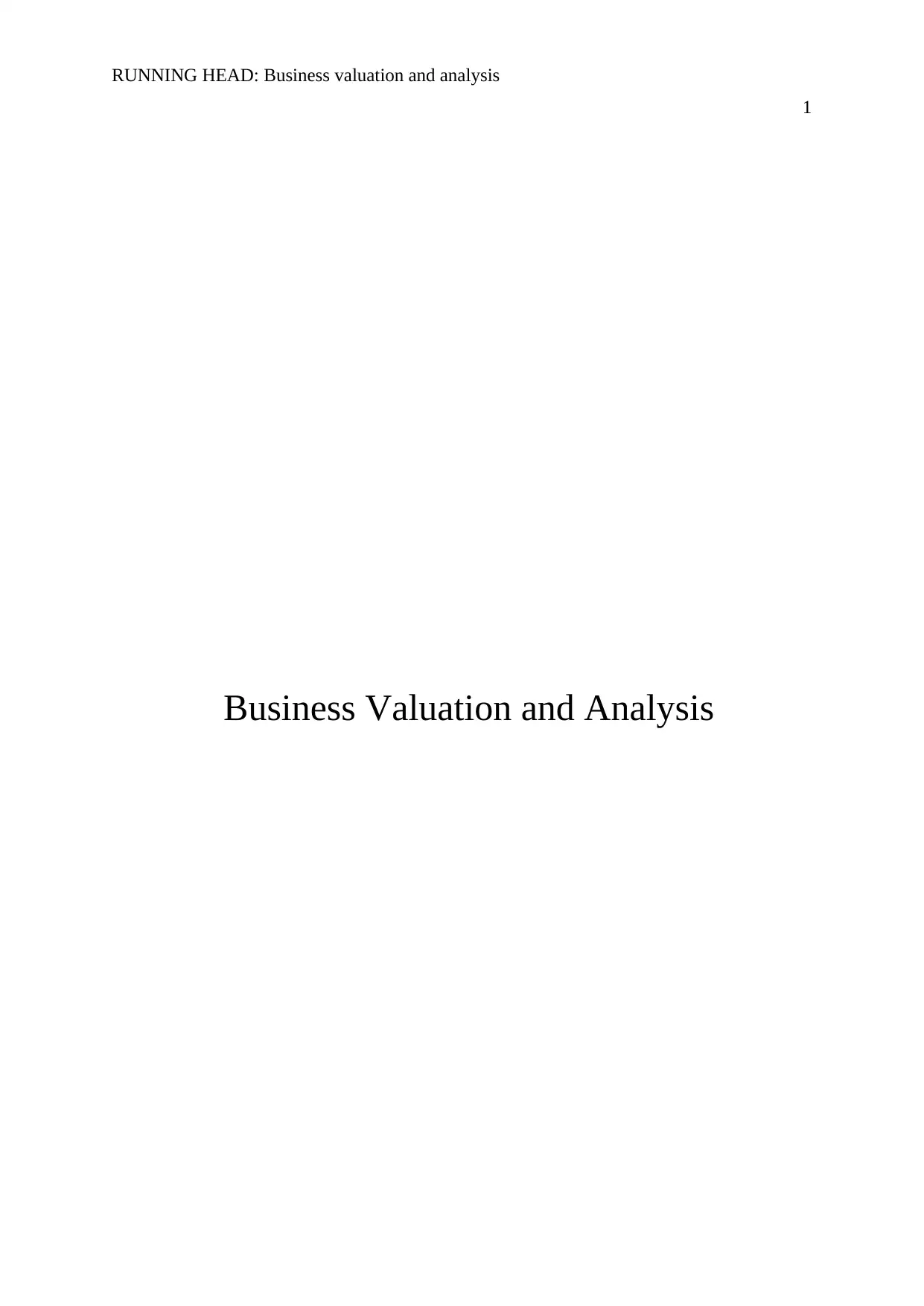
RUNNING HEAD: Business valuation and analysis
1
Business Valuation and Analysis
1
Business Valuation and Analysis
Paraphrase This Document
Need a fresh take? Get an instant paraphrase of this document with our AI Paraphraser
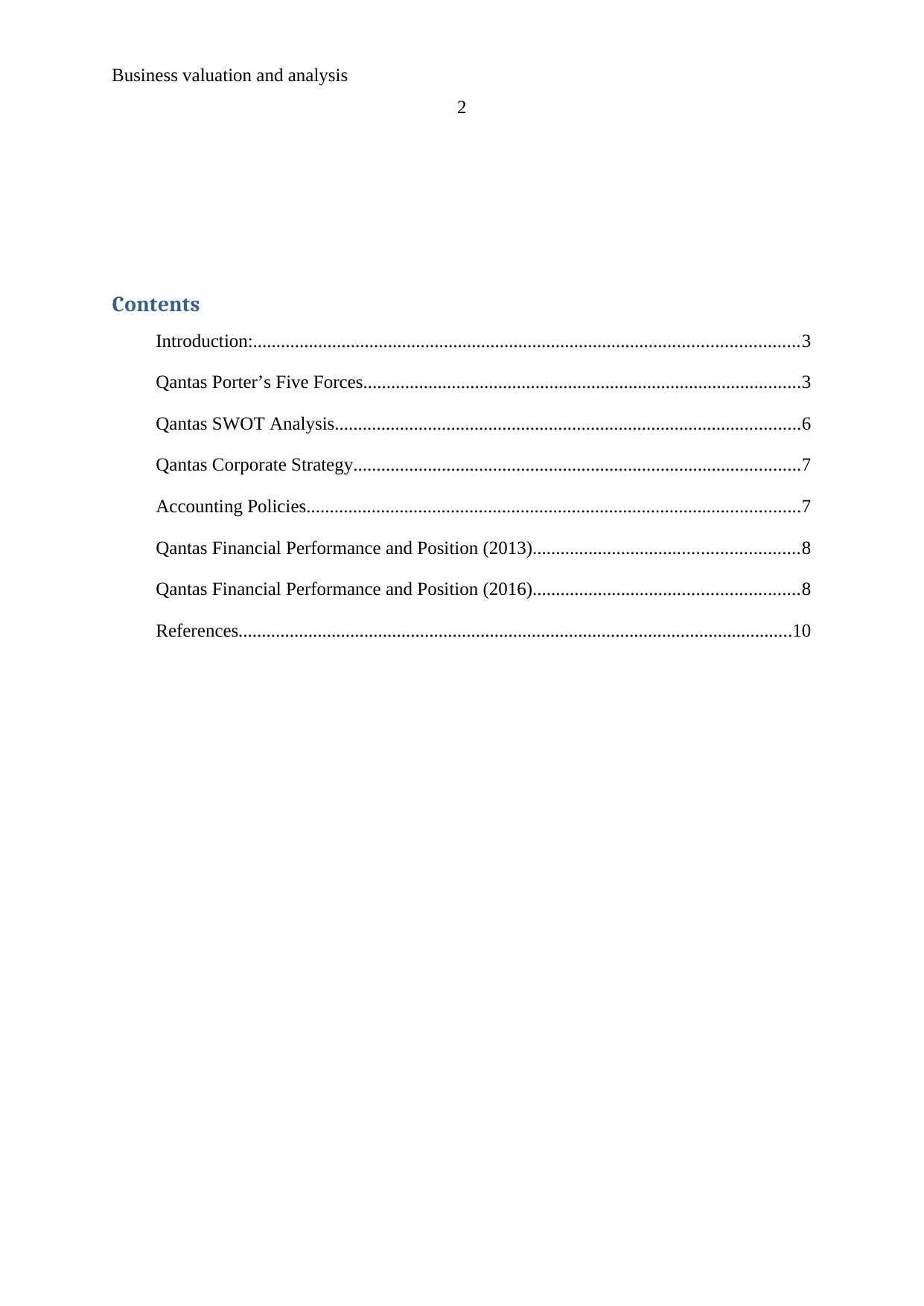
Business valuation and analysis
2
Contents
Introduction:.....................................................................................................................3
Qantas Porter’s Five Forces..............................................................................................3
Qantas SWOT Analysis....................................................................................................6
Qantas Corporate Strategy................................................................................................7
Accounting Policies..........................................................................................................7
Qantas Financial Performance and Position (2013).........................................................8
Qantas Financial Performance and Position (2016).........................................................8
References.......................................................................................................................10
2
Contents
Introduction:.....................................................................................................................3
Qantas Porter’s Five Forces..............................................................................................3
Qantas SWOT Analysis....................................................................................................6
Qantas Corporate Strategy................................................................................................7
Accounting Policies..........................................................................................................7
Qantas Financial Performance and Position (2013).........................................................8
Qantas Financial Performance and Position (2016).........................................................8
References.......................................................................................................................10
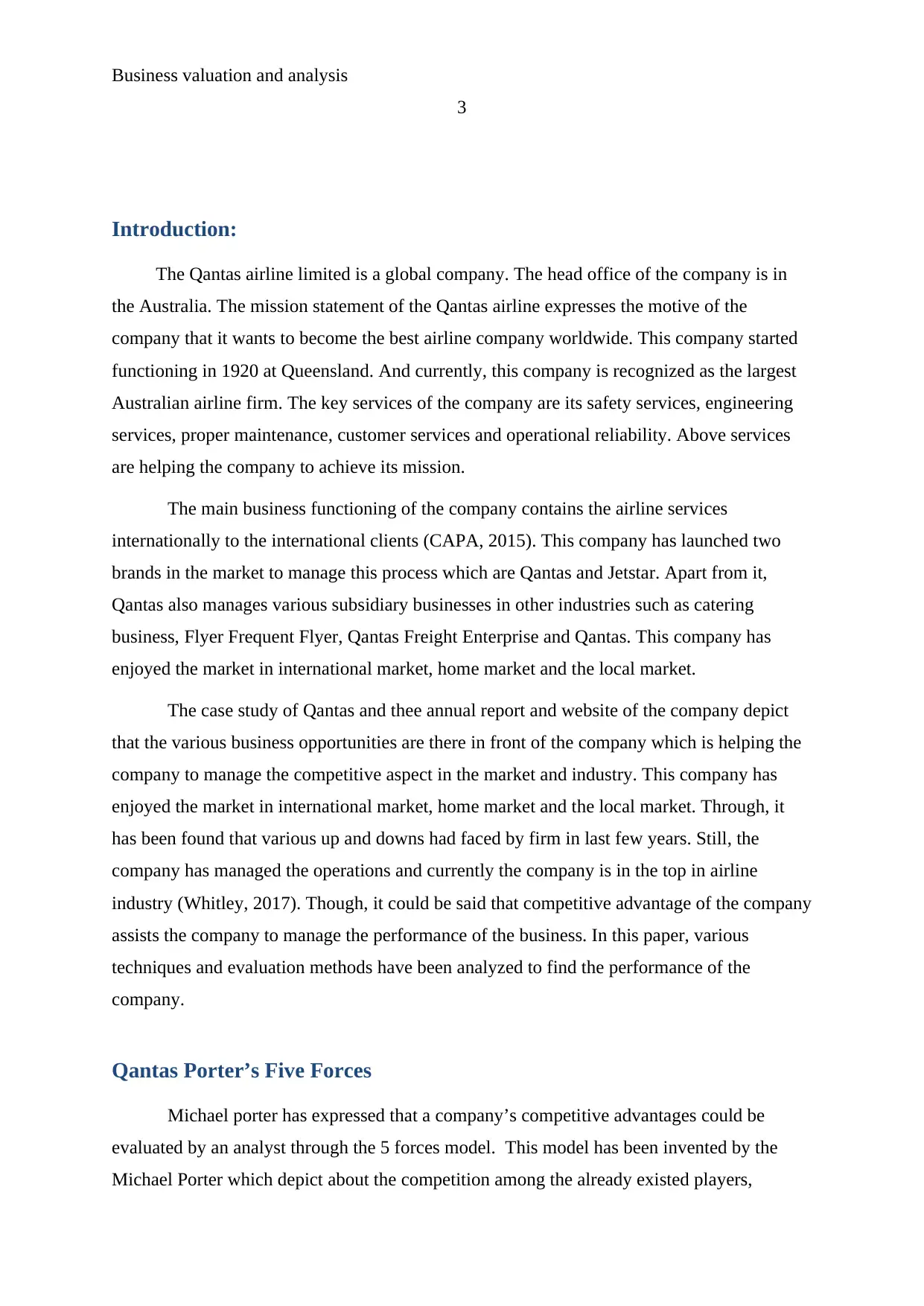
Business valuation and analysis
3
Introduction:
The Qantas airline limited is a global company. The head office of the company is in
the Australia. The mission statement of the Qantas airline expresses the motive of the
company that it wants to become the best airline company worldwide. This company started
functioning in 1920 at Queensland. And currently, this company is recognized as the largest
Australian airline firm. The key services of the company are its safety services, engineering
services, proper maintenance, customer services and operational reliability. Above services
are helping the company to achieve its mission.
The main business functioning of the company contains the airline services
internationally to the international clients (CAPA, 2015). This company has launched two
brands in the market to manage this process which are Qantas and Jetstar. Apart from it,
Qantas also manages various subsidiary businesses in other industries such as catering
business, Flyer Frequent Flyer, Qantas Freight Enterprise and Qantas. This company has
enjoyed the market in international market, home market and the local market.
The case study of Qantas and thee annual report and website of the company depict
that the various business opportunities are there in front of the company which is helping the
company to manage the competitive aspect in the market and industry. This company has
enjoyed the market in international market, home market and the local market. Through, it
has been found that various up and downs had faced by firm in last few years. Still, the
company has managed the operations and currently the company is in the top in airline
industry (Whitley, 2017). Though, it could be said that competitive advantage of the company
assists the company to manage the performance of the business. In this paper, various
techniques and evaluation methods have been analyzed to find the performance of the
company.
Qantas Porter’s Five Forces
Michael porter has expressed that a company’s competitive advantages could be
evaluated by an analyst through the 5 forces model. This model has been invented by the
Michael Porter which depict about the competition among the already existed players,
3
Introduction:
The Qantas airline limited is a global company. The head office of the company is in
the Australia. The mission statement of the Qantas airline expresses the motive of the
company that it wants to become the best airline company worldwide. This company started
functioning in 1920 at Queensland. And currently, this company is recognized as the largest
Australian airline firm. The key services of the company are its safety services, engineering
services, proper maintenance, customer services and operational reliability. Above services
are helping the company to achieve its mission.
The main business functioning of the company contains the airline services
internationally to the international clients (CAPA, 2015). This company has launched two
brands in the market to manage this process which are Qantas and Jetstar. Apart from it,
Qantas also manages various subsidiary businesses in other industries such as catering
business, Flyer Frequent Flyer, Qantas Freight Enterprise and Qantas. This company has
enjoyed the market in international market, home market and the local market.
The case study of Qantas and thee annual report and website of the company depict
that the various business opportunities are there in front of the company which is helping the
company to manage the competitive aspect in the market and industry. This company has
enjoyed the market in international market, home market and the local market. Through, it
has been found that various up and downs had faced by firm in last few years. Still, the
company has managed the operations and currently the company is in the top in airline
industry (Whitley, 2017). Though, it could be said that competitive advantage of the company
assists the company to manage the performance of the business. In this paper, various
techniques and evaluation methods have been analyzed to find the performance of the
company.
Qantas Porter’s Five Forces
Michael porter has expressed that a company’s competitive advantages could be
evaluated by an analyst through the 5 forces model. This model has been invented by the
Michael Porter which depict about the competition among the already existed players,
⊘ This is a preview!⊘
Do you want full access?
Subscribe today to unlock all pages.

Trusted by 1+ million students worldwide
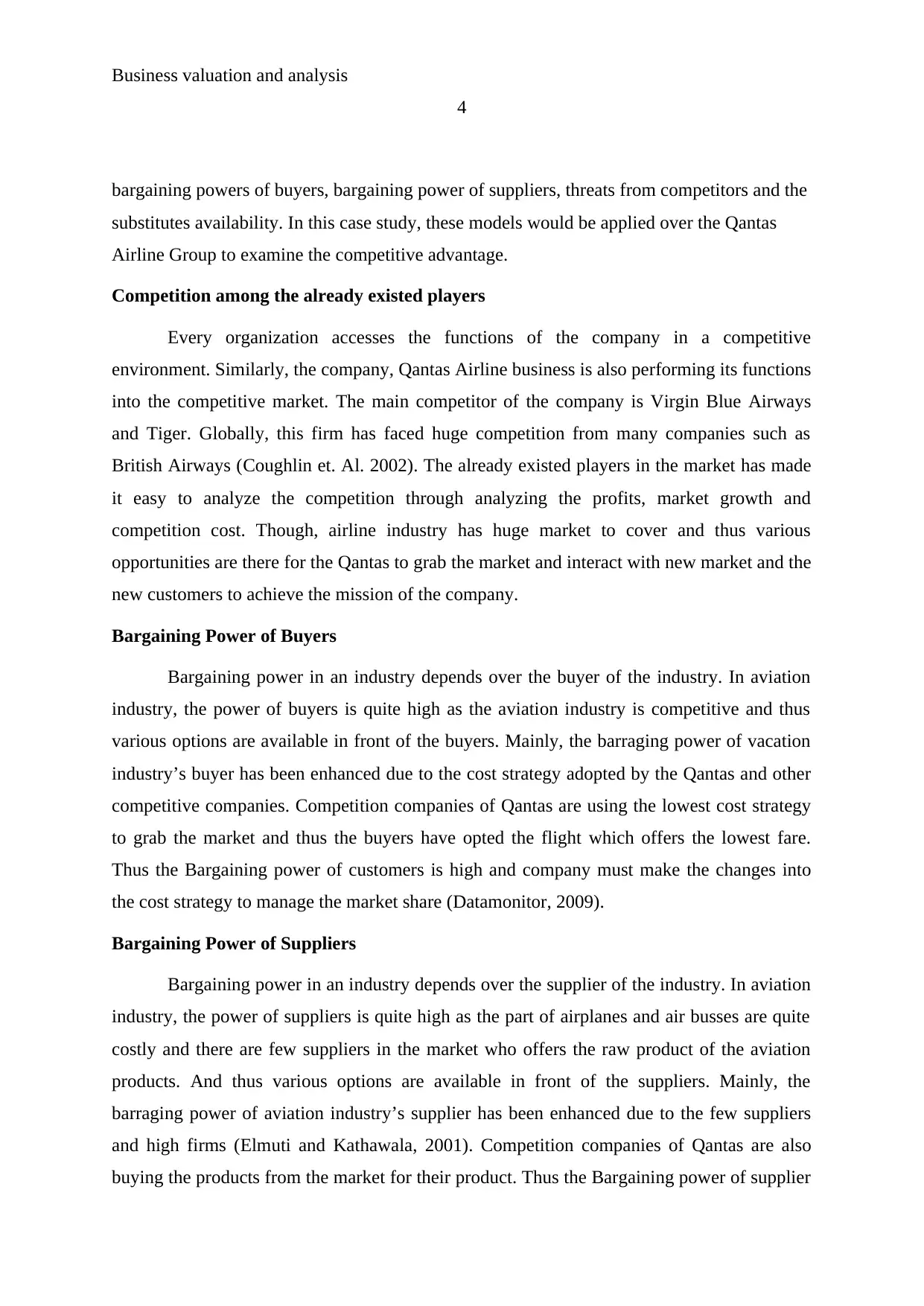
Business valuation and analysis
4
bargaining powers of buyers, bargaining power of suppliers, threats from competitors and the
substitutes availability. In this case study, these models would be applied over the Qantas
Airline Group to examine the competitive advantage.
Competition among the already existed players
Every organization accesses the functions of the company in a competitive
environment. Similarly, the company, Qantas Airline business is also performing its functions
into the competitive market. The main competitor of the company is Virgin Blue Airways
and Tiger. Globally, this firm has faced huge competition from many companies such as
British Airways (Coughlin et. Al. 2002). The already existed players in the market has made
it easy to analyze the competition through analyzing the profits, market growth and
competition cost. Though, airline industry has huge market to cover and thus various
opportunities are there for the Qantas to grab the market and interact with new market and the
new customers to achieve the mission of the company.
Bargaining Power of Buyers
Bargaining power in an industry depends over the buyer of the industry. In aviation
industry, the power of buyers is quite high as the aviation industry is competitive and thus
various options are available in front of the buyers. Mainly, the barraging power of vacation
industry’s buyer has been enhanced due to the cost strategy adopted by the Qantas and other
competitive companies. Competition companies of Qantas are using the lowest cost strategy
to grab the market and thus the buyers have opted the flight which offers the lowest fare.
Thus the Bargaining power of customers is high and company must make the changes into
the cost strategy to manage the market share (Datamonitor, 2009).
Bargaining Power of Suppliers
Bargaining power in an industry depends over the supplier of the industry. In aviation
industry, the power of suppliers is quite high as the part of airplanes and air busses are quite
costly and there are few suppliers in the market who offers the raw product of the aviation
products. And thus various options are available in front of the suppliers. Mainly, the
barraging power of aviation industry’s supplier has been enhanced due to the few suppliers
and high firms (Elmuti and Kathawala, 2001). Competition companies of Qantas are also
buying the products from the market for their product. Thus the Bargaining power of supplier
4
bargaining powers of buyers, bargaining power of suppliers, threats from competitors and the
substitutes availability. In this case study, these models would be applied over the Qantas
Airline Group to examine the competitive advantage.
Competition among the already existed players
Every organization accesses the functions of the company in a competitive
environment. Similarly, the company, Qantas Airline business is also performing its functions
into the competitive market. The main competitor of the company is Virgin Blue Airways
and Tiger. Globally, this firm has faced huge competition from many companies such as
British Airways (Coughlin et. Al. 2002). The already existed players in the market has made
it easy to analyze the competition through analyzing the profits, market growth and
competition cost. Though, airline industry has huge market to cover and thus various
opportunities are there for the Qantas to grab the market and interact with new market and the
new customers to achieve the mission of the company.
Bargaining Power of Buyers
Bargaining power in an industry depends over the buyer of the industry. In aviation
industry, the power of buyers is quite high as the aviation industry is competitive and thus
various options are available in front of the buyers. Mainly, the barraging power of vacation
industry’s buyer has been enhanced due to the cost strategy adopted by the Qantas and other
competitive companies. Competition companies of Qantas are using the lowest cost strategy
to grab the market and thus the buyers have opted the flight which offers the lowest fare.
Thus the Bargaining power of customers is high and company must make the changes into
the cost strategy to manage the market share (Datamonitor, 2009).
Bargaining Power of Suppliers
Bargaining power in an industry depends over the supplier of the industry. In aviation
industry, the power of suppliers is quite high as the part of airplanes and air busses are quite
costly and there are few suppliers in the market who offers the raw product of the aviation
products. And thus various options are available in front of the suppliers. Mainly, the
barraging power of aviation industry’s supplier has been enhanced due to the few suppliers
and high firms (Elmuti and Kathawala, 2001). Competition companies of Qantas are also
buying the products from the market for their product. Thus the Bargaining power of supplier
Paraphrase This Document
Need a fresh take? Get an instant paraphrase of this document with our AI Paraphraser
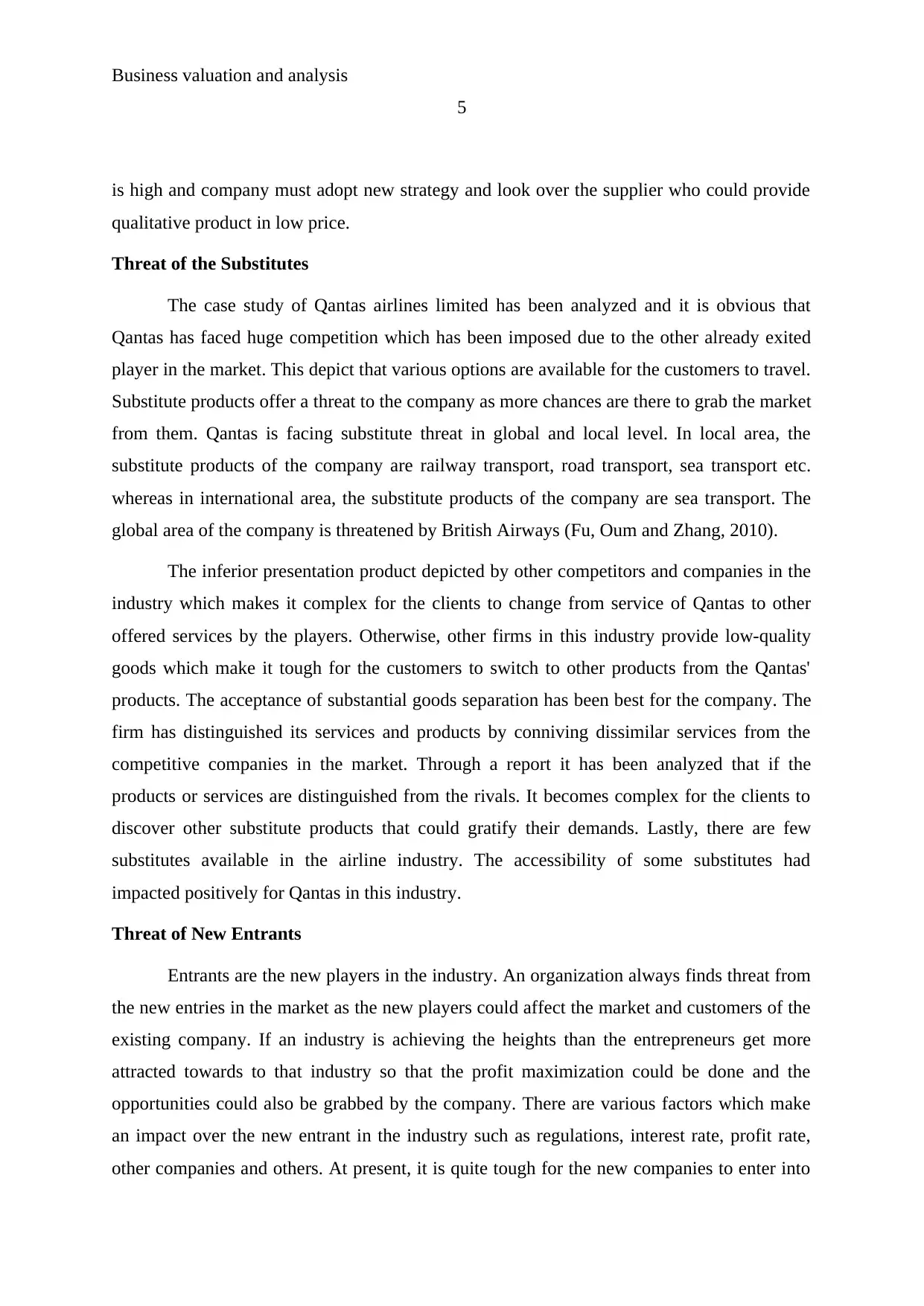
Business valuation and analysis
5
is high and company must adopt new strategy and look over the supplier who could provide
qualitative product in low price.
Threat of the Substitutes
The case study of Qantas airlines limited has been analyzed and it is obvious that
Qantas has faced huge competition which has been imposed due to the other already exited
player in the market. This depict that various options are available for the customers to travel.
Substitute products offer a threat to the company as more chances are there to grab the market
from them. Qantas is facing substitute threat in global and local level. In local area, the
substitute products of the company are railway transport, road transport, sea transport etc.
whereas in international area, the substitute products of the company are sea transport. The
global area of the company is threatened by British Airways (Fu, Oum and Zhang, 2010).
The inferior presentation product depicted by other competitors and companies in the
industry which makes it complex for the clients to change from service of Qantas to other
offered services by the players. Otherwise, other firms in this industry provide low-quality
goods which make it tough for the customers to switch to other products from the Qantas'
products. The acceptance of substantial goods separation has been best for the company. The
firm has distinguished its services and products by conniving dissimilar services from the
competitive companies in the market. Through a report it has been analyzed that if the
products or services are distinguished from the rivals. It becomes complex for the clients to
discover other substitute products that could gratify their demands. Lastly, there are few
substitutes available in the airline industry. The accessibility of some substitutes had
impacted positively for Qantas in this industry.
Threat of New Entrants
Entrants are the new players in the industry. An organization always finds threat from
the new entries in the market as the new players could affect the market and customers of the
existing company. If an industry is achieving the heights than the entrepreneurs get more
attracted towards to that industry so that the profit maximization could be done and the
opportunities could also be grabbed by the company. There are various factors which make
an impact over the new entrant in the industry such as regulations, interest rate, profit rate,
other companies and others. At present, it is quite tough for the new companies to enter into
5
is high and company must adopt new strategy and look over the supplier who could provide
qualitative product in low price.
Threat of the Substitutes
The case study of Qantas airlines limited has been analyzed and it is obvious that
Qantas has faced huge competition which has been imposed due to the other already exited
player in the market. This depict that various options are available for the customers to travel.
Substitute products offer a threat to the company as more chances are there to grab the market
from them. Qantas is facing substitute threat in global and local level. In local area, the
substitute products of the company are railway transport, road transport, sea transport etc.
whereas in international area, the substitute products of the company are sea transport. The
global area of the company is threatened by British Airways (Fu, Oum and Zhang, 2010).
The inferior presentation product depicted by other competitors and companies in the
industry which makes it complex for the clients to change from service of Qantas to other
offered services by the players. Otherwise, other firms in this industry provide low-quality
goods which make it tough for the customers to switch to other products from the Qantas'
products. The acceptance of substantial goods separation has been best for the company. The
firm has distinguished its services and products by conniving dissimilar services from the
competitive companies in the market. Through a report it has been analyzed that if the
products or services are distinguished from the rivals. It becomes complex for the clients to
discover other substitute products that could gratify their demands. Lastly, there are few
substitutes available in the airline industry. The accessibility of some substitutes had
impacted positively for Qantas in this industry.
Threat of New Entrants
Entrants are the new players in the industry. An organization always finds threat from
the new entries in the market as the new players could affect the market and customers of the
existing company. If an industry is achieving the heights than the entrepreneurs get more
attracted towards to that industry so that the profit maximization could be done and the
opportunities could also be grabbed by the company. There are various factors which make
an impact over the new entrant in the industry such as regulations, interest rate, profit rate,
other companies and others. At present, it is quite tough for the new companies to enter into
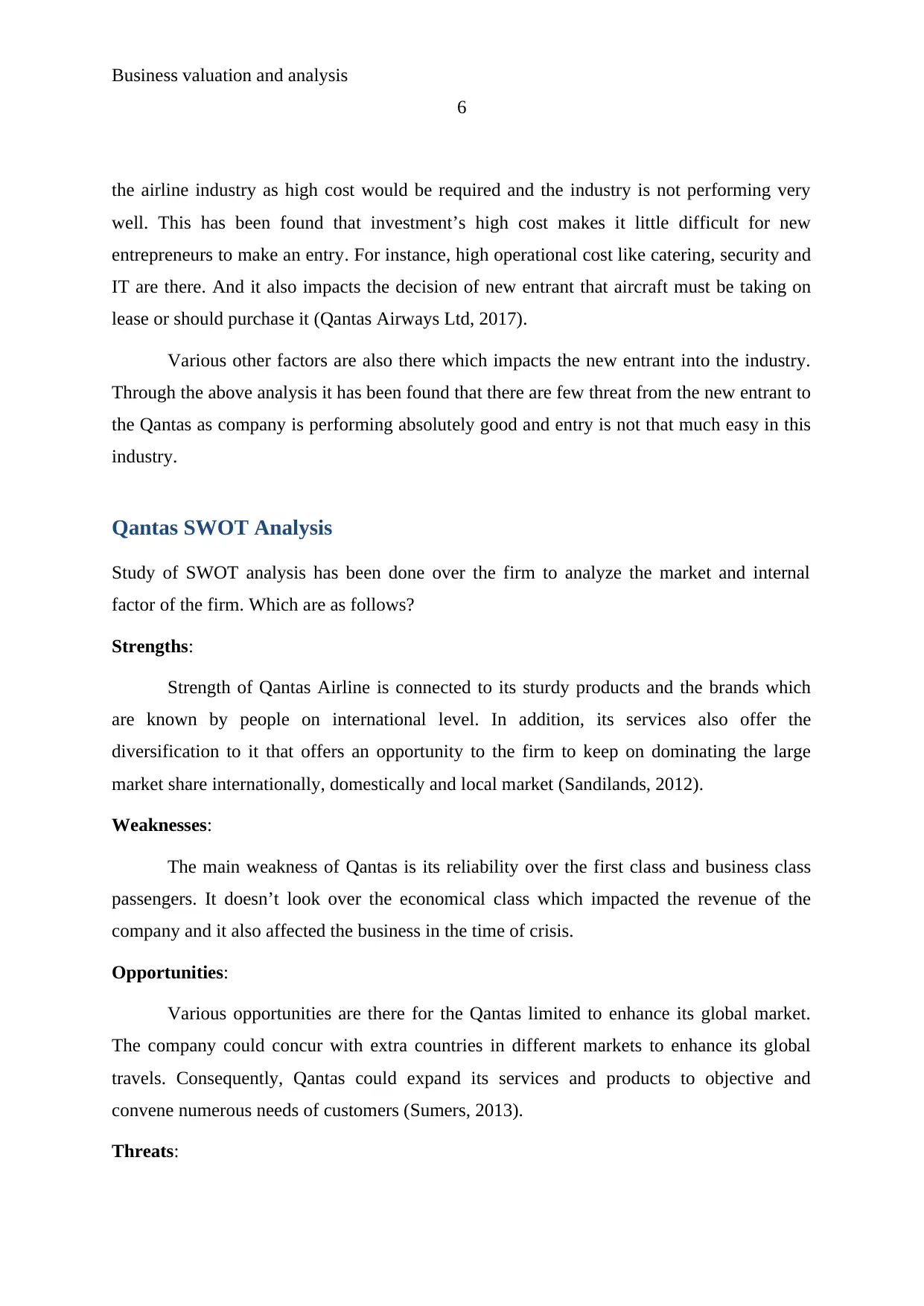
Business valuation and analysis
6
the airline industry as high cost would be required and the industry is not performing very
well. This has been found that investment’s high cost makes it little difficult for new
entrepreneurs to make an entry. For instance, high operational cost like catering, security and
IT are there. And it also impacts the decision of new entrant that aircraft must be taking on
lease or should purchase it (Qantas Airways Ltd, 2017).
Various other factors are also there which impacts the new entrant into the industry.
Through the above analysis it has been found that there are few threat from the new entrant to
the Qantas as company is performing absolutely good and entry is not that much easy in this
industry.
Qantas SWOT Analysis
Study of SWOT analysis has been done over the firm to analyze the market and internal
factor of the firm. Which are as follows?
Strengths:
Strength of Qantas Airline is connected to its sturdy products and the brands which
are known by people on international level. In addition, its services also offer the
diversification to it that offers an opportunity to the firm to keep on dominating the large
market share internationally, domestically and local market (Sandilands, 2012).
Weaknesses:
The main weakness of Qantas is its reliability over the first class and business class
passengers. It doesn’t look over the economical class which impacted the revenue of the
company and it also affected the business in the time of crisis.
Opportunities:
Various opportunities are there for the Qantas limited to enhance its global market.
The company could concur with extra countries in different markets to enhance its global
travels. Consequently, Qantas could expand its services and products to objective and
convene numerous needs of customers (Sumers, 2013).
Threats:
6
the airline industry as high cost would be required and the industry is not performing very
well. This has been found that investment’s high cost makes it little difficult for new
entrepreneurs to make an entry. For instance, high operational cost like catering, security and
IT are there. And it also impacts the decision of new entrant that aircraft must be taking on
lease or should purchase it (Qantas Airways Ltd, 2017).
Various other factors are also there which impacts the new entrant into the industry.
Through the above analysis it has been found that there are few threat from the new entrant to
the Qantas as company is performing absolutely good and entry is not that much easy in this
industry.
Qantas SWOT Analysis
Study of SWOT analysis has been done over the firm to analyze the market and internal
factor of the firm. Which are as follows?
Strengths:
Strength of Qantas Airline is connected to its sturdy products and the brands which
are known by people on international level. In addition, its services also offer the
diversification to it that offers an opportunity to the firm to keep on dominating the large
market share internationally, domestically and local market (Sandilands, 2012).
Weaknesses:
The main weakness of Qantas is its reliability over the first class and business class
passengers. It doesn’t look over the economical class which impacted the revenue of the
company and it also affected the business in the time of crisis.
Opportunities:
Various opportunities are there for the Qantas limited to enhance its global market.
The company could concur with extra countries in different markets to enhance its global
travels. Consequently, Qantas could expand its services and products to objective and
convene numerous needs of customers (Sumers, 2013).
Threats:
⊘ This is a preview!⊘
Do you want full access?
Subscribe today to unlock all pages.

Trusted by 1+ million students worldwide
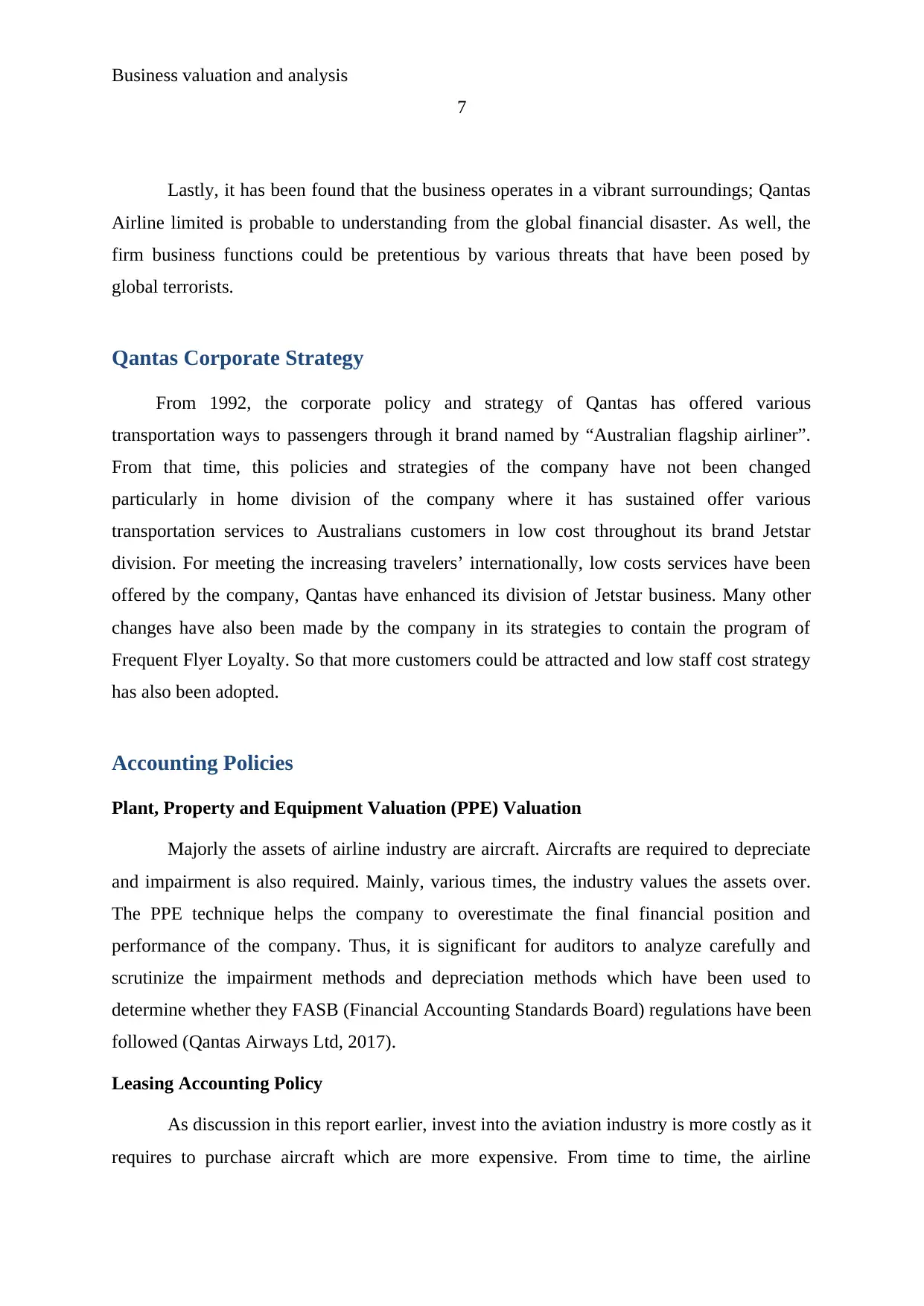
Business valuation and analysis
7
Lastly, it has been found that the business operates in a vibrant surroundings; Qantas
Airline limited is probable to understanding from the global financial disaster. As well, the
firm business functions could be pretentious by various threats that have been posed by
global terrorists.
Qantas Corporate Strategy
From 1992, the corporate policy and strategy of Qantas has offered various
transportation ways to passengers through it brand named by “Australian flagship airliner”.
From that time, this policies and strategies of the company have not been changed
particularly in home division of the company where it has sustained offer various
transportation services to Australians customers in low cost throughout its brand Jetstar
division. For meeting the increasing travelers’ internationally, low costs services have been
offered by the company, Qantas have enhanced its division of Jetstar business. Many other
changes have also been made by the company in its strategies to contain the program of
Frequent Flyer Loyalty. So that more customers could be attracted and low staff cost strategy
has also been adopted.
Accounting Policies
Plant, Property and Equipment Valuation (PPE) Valuation
Majorly the assets of airline industry are aircraft. Aircrafts are required to depreciate
and impairment is also required. Mainly, various times, the industry values the assets over.
The PPE technique helps the company to overestimate the final financial position and
performance of the company. Thus, it is significant for auditors to analyze carefully and
scrutinize the impairment methods and depreciation methods which have been used to
determine whether they FASB (Financial Accounting Standards Board) regulations have been
followed (Qantas Airways Ltd, 2017).
Leasing Accounting Policy
As discussion in this report earlier, invest into the aviation industry is more costly as it
requires to purchase aircraft which are more expensive. From time to time, the airline
7
Lastly, it has been found that the business operates in a vibrant surroundings; Qantas
Airline limited is probable to understanding from the global financial disaster. As well, the
firm business functions could be pretentious by various threats that have been posed by
global terrorists.
Qantas Corporate Strategy
From 1992, the corporate policy and strategy of Qantas has offered various
transportation ways to passengers through it brand named by “Australian flagship airliner”.
From that time, this policies and strategies of the company have not been changed
particularly in home division of the company where it has sustained offer various
transportation services to Australians customers in low cost throughout its brand Jetstar
division. For meeting the increasing travelers’ internationally, low costs services have been
offered by the company, Qantas have enhanced its division of Jetstar business. Many other
changes have also been made by the company in its strategies to contain the program of
Frequent Flyer Loyalty. So that more customers could be attracted and low staff cost strategy
has also been adopted.
Accounting Policies
Plant, Property and Equipment Valuation (PPE) Valuation
Majorly the assets of airline industry are aircraft. Aircrafts are required to depreciate
and impairment is also required. Mainly, various times, the industry values the assets over.
The PPE technique helps the company to overestimate the final financial position and
performance of the company. Thus, it is significant for auditors to analyze carefully and
scrutinize the impairment methods and depreciation methods which have been used to
determine whether they FASB (Financial Accounting Standards Board) regulations have been
followed (Qantas Airways Ltd, 2017).
Leasing Accounting Policy
As discussion in this report earlier, invest into the aviation industry is more costly as it
requires to purchase aircraft which are more expensive. From time to time, the airline
Paraphrase This Document
Need a fresh take? Get an instant paraphrase of this document with our AI Paraphraser
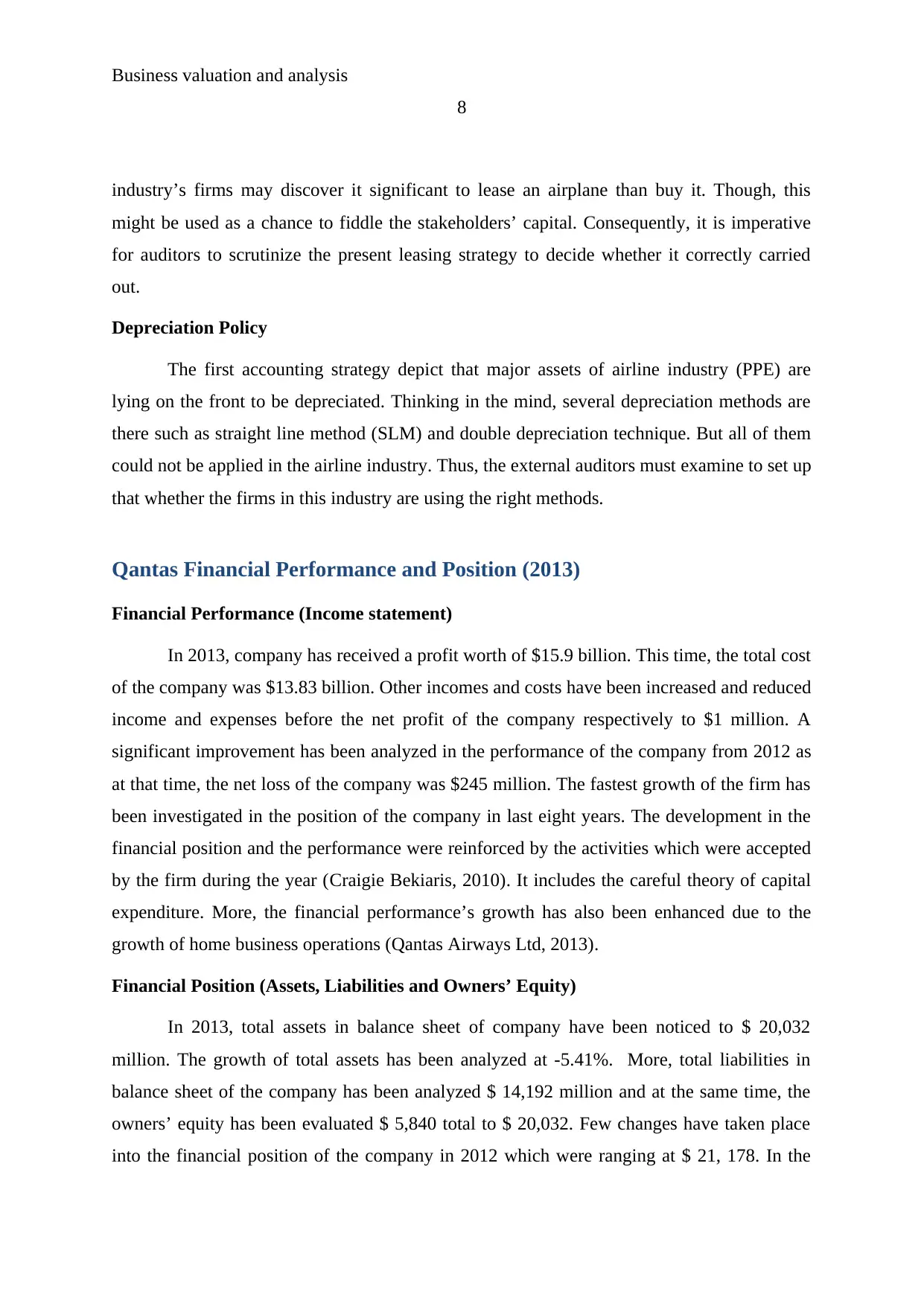
Business valuation and analysis
8
industry’s firms may discover it significant to lease an airplane than buy it. Though, this
might be used as a chance to fiddle the stakeholders’ capital. Consequently, it is imperative
for auditors to scrutinize the present leasing strategy to decide whether it correctly carried
out.
Depreciation Policy
The first accounting strategy depict that major assets of airline industry (PPE) are
lying on the front to be depreciated. Thinking in the mind, several depreciation methods are
there such as straight line method (SLM) and double depreciation technique. But all of them
could not be applied in the airline industry. Thus, the external auditors must examine to set up
that whether the firms in this industry are using the right methods.
Qantas Financial Performance and Position (2013)
Financial Performance (Income statement)
In 2013, company has received a profit worth of $15.9 billion. This time, the total cost
of the company was $13.83 billion. Other incomes and costs have been increased and reduced
income and expenses before the net profit of the company respectively to $1 million. A
significant improvement has been analyzed in the performance of the company from 2012 as
at that time, the net loss of the company was $245 million. The fastest growth of the firm has
been investigated in the position of the company in last eight years. The development in the
financial position and the performance were reinforced by the activities which were accepted
by the firm during the year (Craigie Bekiaris, 2010). It includes the careful theory of capital
expenditure. More, the financial performance’s growth has also been enhanced due to the
growth of home business operations (Qantas Airways Ltd, 2013).
Financial Position (Assets, Liabilities and Owners’ Equity)
In 2013, total assets in balance sheet of company have been noticed to $ 20,032
million. The growth of total assets has been analyzed at -5.41%. More, total liabilities in
balance sheet of the company has been analyzed $ 14,192 million and at the same time, the
owners’ equity has been evaluated $ 5,840 total to $ 20,032. Few changes have taken place
into the financial position of the company in 2012 which were ranging at $ 21, 178. In the
8
industry’s firms may discover it significant to lease an airplane than buy it. Though, this
might be used as a chance to fiddle the stakeholders’ capital. Consequently, it is imperative
for auditors to scrutinize the present leasing strategy to decide whether it correctly carried
out.
Depreciation Policy
The first accounting strategy depict that major assets of airline industry (PPE) are
lying on the front to be depreciated. Thinking in the mind, several depreciation methods are
there such as straight line method (SLM) and double depreciation technique. But all of them
could not be applied in the airline industry. Thus, the external auditors must examine to set up
that whether the firms in this industry are using the right methods.
Qantas Financial Performance and Position (2013)
Financial Performance (Income statement)
In 2013, company has received a profit worth of $15.9 billion. This time, the total cost
of the company was $13.83 billion. Other incomes and costs have been increased and reduced
income and expenses before the net profit of the company respectively to $1 million. A
significant improvement has been analyzed in the performance of the company from 2012 as
at that time, the net loss of the company was $245 million. The fastest growth of the firm has
been investigated in the position of the company in last eight years. The development in the
financial position and the performance were reinforced by the activities which were accepted
by the firm during the year (Craigie Bekiaris, 2010). It includes the careful theory of capital
expenditure. More, the financial performance’s growth has also been enhanced due to the
growth of home business operations (Qantas Airways Ltd, 2013).
Financial Position (Assets, Liabilities and Owners’ Equity)
In 2013, total assets in balance sheet of company have been noticed to $ 20,032
million. The growth of total assets has been analyzed at -5.41%. More, total liabilities in
balance sheet of the company has been analyzed $ 14,192 million and at the same time, the
owners’ equity has been evaluated $ 5,840 total to $ 20,032. Few changes have taken place
into the financial position of the company in 2012 which were ranging at $ 21, 178. In the
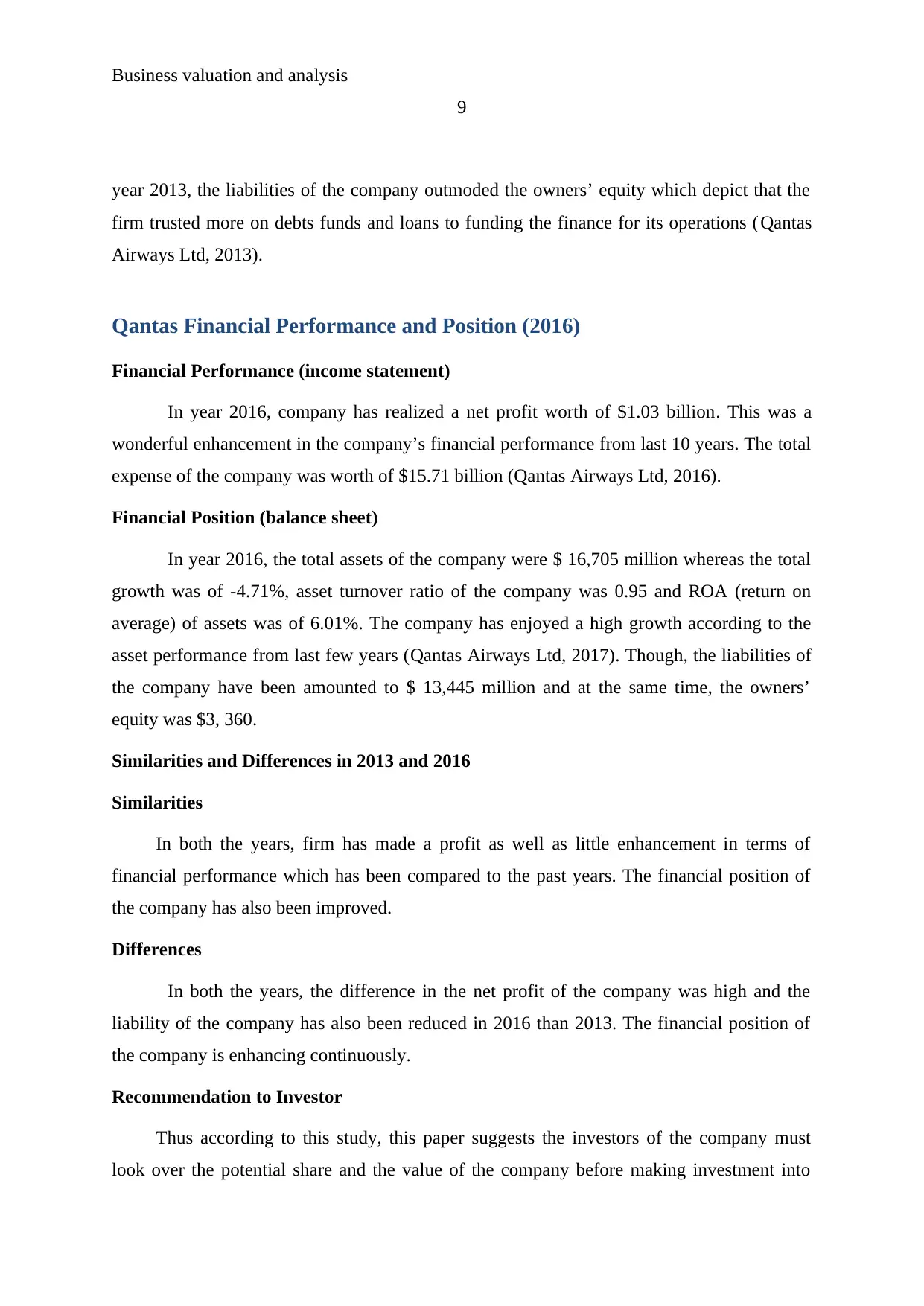
Business valuation and analysis
9
year 2013, the liabilities of the company outmoded the owners’ equity which depict that the
firm trusted more on debts funds and loans to funding the finance for its operations (Qantas
Airways Ltd, 2013).
Qantas Financial Performance and Position (2016)
Financial Performance (income statement)
In year 2016, company has realized a net profit worth of $1.03 billion. This was a
wonderful enhancement in the company’s financial performance from last 10 years. The total
expense of the company was worth of $15.71 billion (Qantas Airways Ltd, 2016).
Financial Position (balance sheet)
In year 2016, the total assets of the company were $ 16,705 million whereas the total
growth was of -4.71%, asset turnover ratio of the company was 0.95 and ROA (return on
average) of assets was of 6.01%. The company has enjoyed a high growth according to the
asset performance from last few years (Qantas Airways Ltd, 2017). Though, the liabilities of
the company have been amounted to $ 13,445 million and at the same time, the owners’
equity was $3, 360.
Similarities and Differences in 2013 and 2016
Similarities
In both the years, firm has made a profit as well as little enhancement in terms of
financial performance which has been compared to the past years. The financial position of
the company has also been improved.
Differences
In both the years, the difference in the net profit of the company was high and the
liability of the company has also been reduced in 2016 than 2013. The financial position of
the company is enhancing continuously.
Recommendation to Investor
Thus according to this study, this paper suggests the investors of the company must
look over the potential share and the value of the company before making investment into
9
year 2013, the liabilities of the company outmoded the owners’ equity which depict that the
firm trusted more on debts funds and loans to funding the finance for its operations (Qantas
Airways Ltd, 2013).
Qantas Financial Performance and Position (2016)
Financial Performance (income statement)
In year 2016, company has realized a net profit worth of $1.03 billion. This was a
wonderful enhancement in the company’s financial performance from last 10 years. The total
expense of the company was worth of $15.71 billion (Qantas Airways Ltd, 2016).
Financial Position (balance sheet)
In year 2016, the total assets of the company were $ 16,705 million whereas the total
growth was of -4.71%, asset turnover ratio of the company was 0.95 and ROA (return on
average) of assets was of 6.01%. The company has enjoyed a high growth according to the
asset performance from last few years (Qantas Airways Ltd, 2017). Though, the liabilities of
the company have been amounted to $ 13,445 million and at the same time, the owners’
equity was $3, 360.
Similarities and Differences in 2013 and 2016
Similarities
In both the years, firm has made a profit as well as little enhancement in terms of
financial performance which has been compared to the past years. The financial position of
the company has also been improved.
Differences
In both the years, the difference in the net profit of the company was high and the
liability of the company has also been reduced in 2016 than 2013. The financial position of
the company is enhancing continuously.
Recommendation to Investor
Thus according to this study, this paper suggests the investors of the company must
look over the potential share and the value of the company before making investment into
⊘ This is a preview!⊘
Do you want full access?
Subscribe today to unlock all pages.

Trusted by 1+ million students worldwide
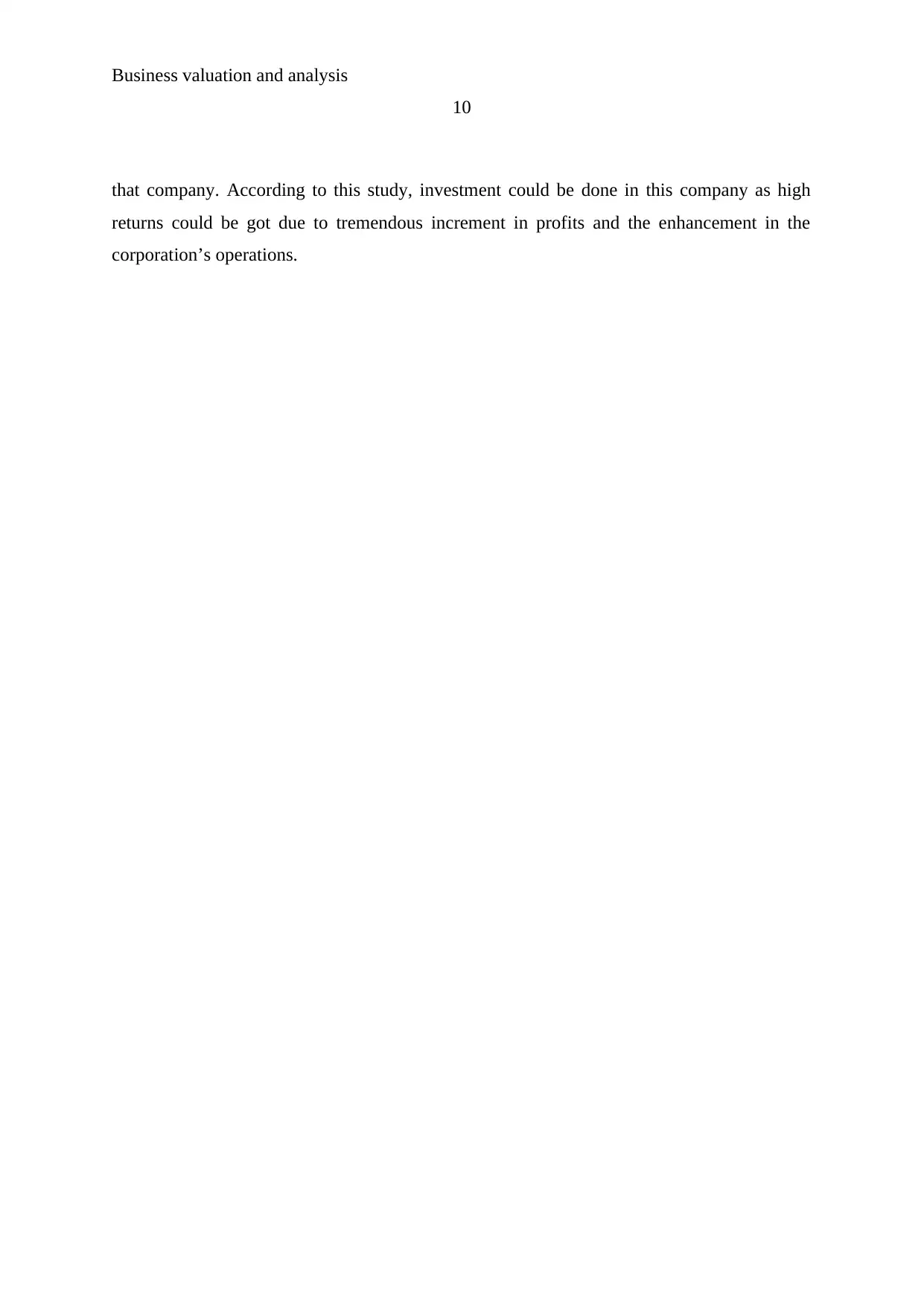
Business valuation and analysis
10
that company. According to this study, investment could be done in this company as high
returns could be got due to tremendous increment in profits and the enhancement in the
corporation’s operations.
10
that company. According to this study, investment could be done in this company as high
returns could be got due to tremendous increment in profits and the enhancement in the
corporation’s operations.
Paraphrase This Document
Need a fresh take? Get an instant paraphrase of this document with our AI Paraphraser
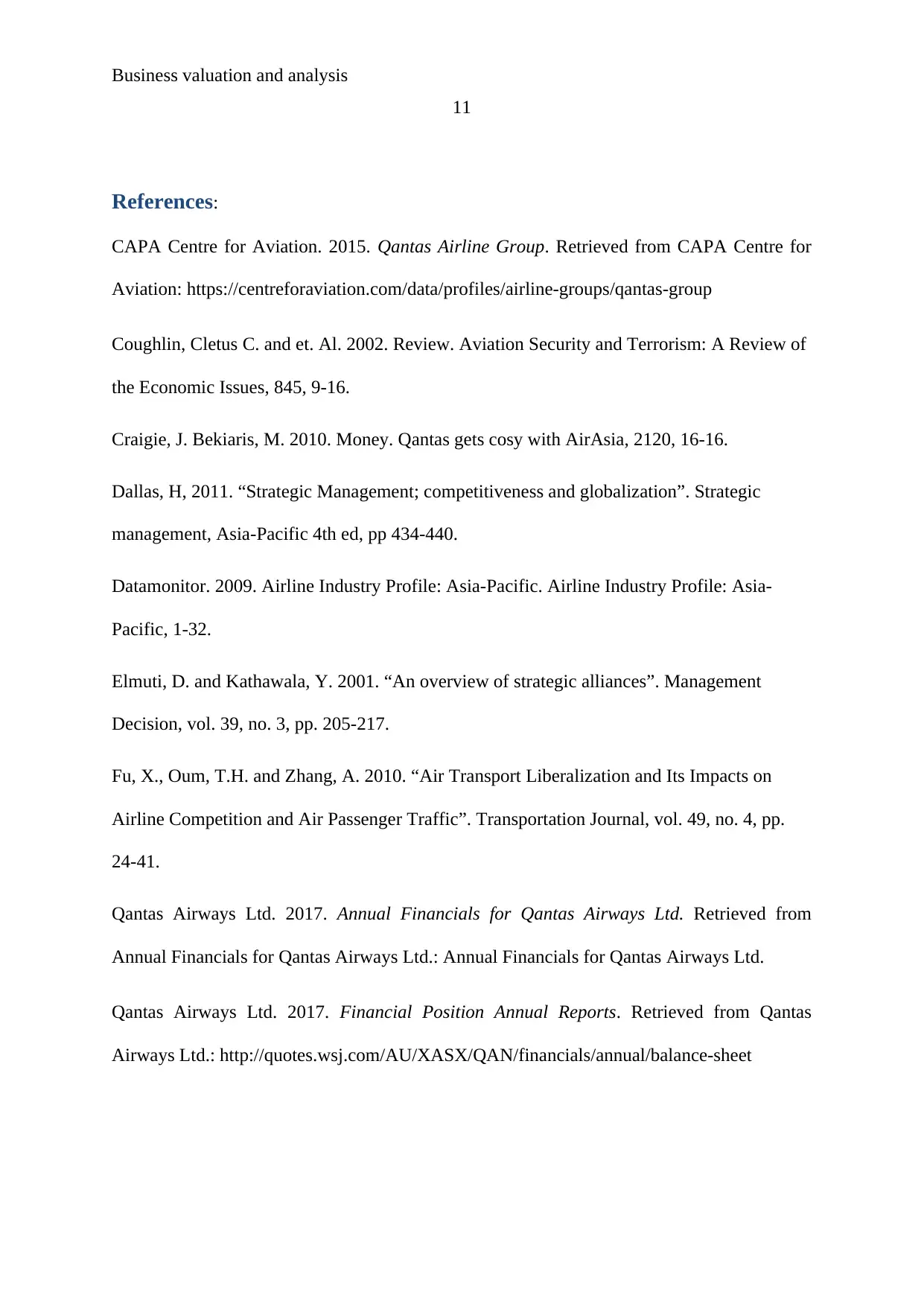
Business valuation and analysis
11
References:
CAPA Centre for Aviation. 2015. Qantas Airline Group. Retrieved from CAPA Centre for
Aviation: https://centreforaviation.com/data/profiles/airline-groups/qantas-group
Coughlin, Cletus C. and et. Al. 2002. Review. Aviation Security and Terrorism: A Review of
the Economic Issues, 845, 9-16.
Craigie, J. Bekiaris, M. 2010. Money. Qantas gets cosy with AirAsia, 2120, 16-16.
Dallas, H, 2011. “Strategic Management; competitiveness and globalization”. Strategic
management, Asia-Pacific 4th ed, pp 434-440.
Datamonitor. 2009. Airline Industry Profile: Asia-Pacific. Airline Industry Profile: Asia-
Pacific, 1-32.
Elmuti, D. and Kathawala, Y. 2001. “An overview of strategic alliances”. Management
Decision, vol. 39, no. 3, pp. 205-217.
Fu, X., Oum, T.H. and Zhang, A. 2010. “Air Transport Liberalization and Its Impacts on
Airline Competition and Air Passenger Traffic”. Transportation Journal, vol. 49, no. 4, pp.
24-41.
Qantas Airways Ltd. 2017. Annual Financials for Qantas Airways Ltd. Retrieved from
Annual Financials for Qantas Airways Ltd.: Annual Financials for Qantas Airways Ltd.
Qantas Airways Ltd. 2017. Financial Position Annual Reports. Retrieved from Qantas
Airways Ltd.: http://quotes.wsj.com/AU/XASX/QAN/financials/annual/balance-sheet
11
References:
CAPA Centre for Aviation. 2015. Qantas Airline Group. Retrieved from CAPA Centre for
Aviation: https://centreforaviation.com/data/profiles/airline-groups/qantas-group
Coughlin, Cletus C. and et. Al. 2002. Review. Aviation Security and Terrorism: A Review of
the Economic Issues, 845, 9-16.
Craigie, J. Bekiaris, M. 2010. Money. Qantas gets cosy with AirAsia, 2120, 16-16.
Dallas, H, 2011. “Strategic Management; competitiveness and globalization”. Strategic
management, Asia-Pacific 4th ed, pp 434-440.
Datamonitor. 2009. Airline Industry Profile: Asia-Pacific. Airline Industry Profile: Asia-
Pacific, 1-32.
Elmuti, D. and Kathawala, Y. 2001. “An overview of strategic alliances”. Management
Decision, vol. 39, no. 3, pp. 205-217.
Fu, X., Oum, T.H. and Zhang, A. 2010. “Air Transport Liberalization and Its Impacts on
Airline Competition and Air Passenger Traffic”. Transportation Journal, vol. 49, no. 4, pp.
24-41.
Qantas Airways Ltd. 2017. Annual Financials for Qantas Airways Ltd. Retrieved from
Annual Financials for Qantas Airways Ltd.: Annual Financials for Qantas Airways Ltd.
Qantas Airways Ltd. 2017. Financial Position Annual Reports. Retrieved from Qantas
Airways Ltd.: http://quotes.wsj.com/AU/XASX/QAN/financials/annual/balance-sheet
1 out of 11
Related Documents
Your All-in-One AI-Powered Toolkit for Academic Success.
+13062052269
info@desklib.com
Available 24*7 on WhatsApp / Email
![[object Object]](/_next/static/media/star-bottom.7253800d.svg)
Unlock your academic potential
Copyright © 2020–2025 A2Z Services. All Rights Reserved. Developed and managed by ZUCOL.





